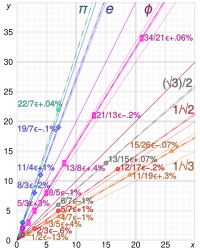Geometry of numbers

Okay kiddo, have you ever played with Legos before? You know how you can build things with them and make different shapes and patterns by putting the blocks together? Well, the geometry of numbers is a lot like playing with Legos, but instead of blocks we use numbers!
Imagine you have a big block of wood, and you want to paint it using only two colors: red and blue. You can paint each little square on the block with either red or blue, but you have to color it completely with only one color. Now, if you wanted to know how many different patterns you can make with the two colors, you could try counting them all, but that would take forever! Instead, you can use the geometry of numbers to help you figure it out.
You see, the geometry of numbers uses a system of lines and grids to organize numbers and allow us to see patterns and relationships between them. Each line represents a different number, and we can plot those numbers on the grid. For example, we can plot the numbers 1 and 2 as two different points on the grid, and we can draw a line between them to show that those two numbers are related.
Now, going back to our painted block, let's say we want to know how many different patterns we can make using only red and blue. We can plot the number 1 as a point on the grid and draw a line between that point and the point representing the number 2. This line represents all the different combinations of colors we can make using only one square of each color. But we don't just have one square to paint, we have a whole block! So we need to find all the different patterns we can make using multiple squares of each color.
Luckily, the geometry of numbers can help us do this too! We can draw another line on the grid, this time representing the number 3. We can draw this line by plotting the point representing 3, and then drawing a line between that point and the point representing 1+2=3. This line represents all the different combinations of colors we can make using two squares of one color and one square of the other color.
We can keep doing this for higher numbers, drawing lines on the grid to represent all the different combinations of colors we can make using different numbers of squares of each color. And by looking at these lines and the points where they intersect, we can see how many different patterns we can make with two colors on our block of wood!
So you see, using the geometry of numbers is like playing with Legos, but instead of building things with blocks we build patterns with numbers. We use lines and grids to organize the numbers and see relationships between them, and we can use this to solve problems and answer questions about patterns and structures in the world around us. Pretty cool, huh?
Imagine you have a big block of wood, and you want to paint it using only two colors: red and blue. You can paint each little square on the block with either red or blue, but you have to color it completely with only one color. Now, if you wanted to know how many different patterns you can make with the two colors, you could try counting them all, but that would take forever! Instead, you can use the geometry of numbers to help you figure it out.
You see, the geometry of numbers uses a system of lines and grids to organize numbers and allow us to see patterns and relationships between them. Each line represents a different number, and we can plot those numbers on the grid. For example, we can plot the numbers 1 and 2 as two different points on the grid, and we can draw a line between them to show that those two numbers are related.
Now, going back to our painted block, let's say we want to know how many different patterns we can make using only red and blue. We can plot the number 1 as a point on the grid and draw a line between that point and the point representing the number 2. This line represents all the different combinations of colors we can make using only one square of each color. But we don't just have one square to paint, we have a whole block! So we need to find all the different patterns we can make using multiple squares of each color.
Luckily, the geometry of numbers can help us do this too! We can draw another line on the grid, this time representing the number 3. We can draw this line by plotting the point representing 3, and then drawing a line between that point and the point representing 1+2=3. This line represents all the different combinations of colors we can make using two squares of one color and one square of the other color.
We can keep doing this for higher numbers, drawing lines on the grid to represent all the different combinations of colors we can make using different numbers of squares of each color. And by looking at these lines and the points where they intersect, we can see how many different patterns we can make with two colors on our block of wood!
So you see, using the geometry of numbers is like playing with Legos, but instead of building things with blocks we build patterns with numbers. We use lines and grids to organize the numbers and see relationships between them, and we can use this to solve problems and answer questions about patterns and structures in the world around us. Pretty cool, huh?
